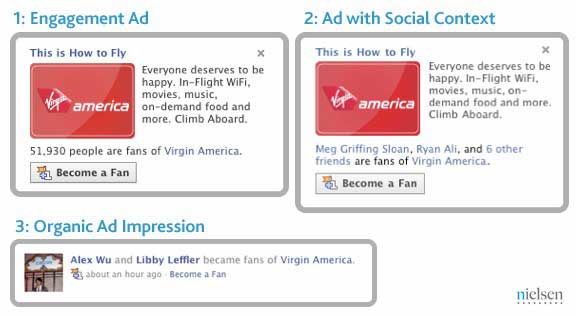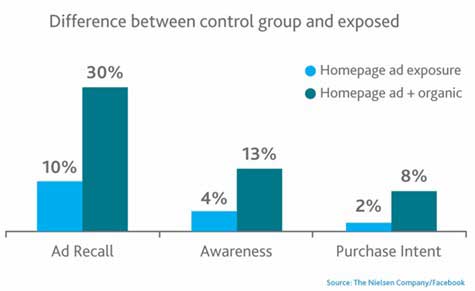Homepage ads on Facebook that have social media context—that is, they include the names of users' friends who are already fans of the brand—are 4.0 times more likely than those that don't to increase purchase intent of a product or brand, twice as likely to increase awareness, and 1.6 times as likely to increase recall, according to a study conducted jointly by Nielsen and Facebook.
By contrast, among standard homepage ads, with no social context, recall increased on average just 10% between exposed and control audiences following ad exposure on Facebook. Awareness increased on average 4% and purchase intent increased 2%.

The study examined the effectiveness of three types of media on Facebook:
- Standard homepage ads: Paid media, which contain ad creative as well as an option for users to engage with the brand (e.g., "Become a Fan").
- Homepage ads with social context: A hybrid of paid and earned media, which include the names of a user's friends who are already fans of the brand.
- Organic impressions: Earned media, which are social, newsfeed stories sent to friends of users who engage with advertising on a brand.

Value of Organic Impressions
Users exposed to both a paid homepage ad and an organic impression were 3.0 times more likely to remember the ad than those exposed to just the paid homepage ad.

Meanwhile, product or brand awareness was on average 3.3 times higher among consumers exposed to both homepage ads and organic impressions; purchase intent was 4.0 times higher.
Looking for real-world examples of businesses achieving their social media marketing goals? Our 47-page case-study collection, Facebook Success Stories, shows you how to increase brand awareness, target specific markets, promote new products, and create communities that engage users. Also check out The State of Social Media Marketing, a 240-page original research report from MarketingProfs.
Organic Frequency Drives Impact
Recall, awareness, and purchase intent continue to increase even after 10 or more exposures to an organic message. That finding is in great contrast to the four impressions that usually influence growth in such dimensions for standard display campaigns, according to the study.

Moreover, the jump in awareness between those consumers exposed to between three and nine organic messages (13%) and those exposed to 10+ messages (28%) is a sizeable 15 percentage points.
Other findings
- Because organic impressions are generated through interactions with the ad unit (which are then posted as stories in friends' feeds), there is a strong relationship between the engagement rate of an ad campaign and the number of organic impressions.
- Social impressions, which carry an added layer of influence by naming which of the user's friends also have a relationship with the brand, are strongly related to the size of the brand's fan base before the start of their ad campaign.
- Rather than viewing social media as a platform only for "earned" media, there is significant benefit, especially in ad recall, to both "seeding" social networks with paid ads and maximizing lightweight forms of social advocacy such as social impressions that demonstrate significant reach.
About the data: Finding are from the joint Nielsen and Facebook report titled Advertising Effectiveness: Understanding the Value of a Social Media Impression, which analyzed survey data from more than 800,000 Facebook users in response to more than 125 Facebook ad campaigns from 70 brand advertisers over a six-month period.



